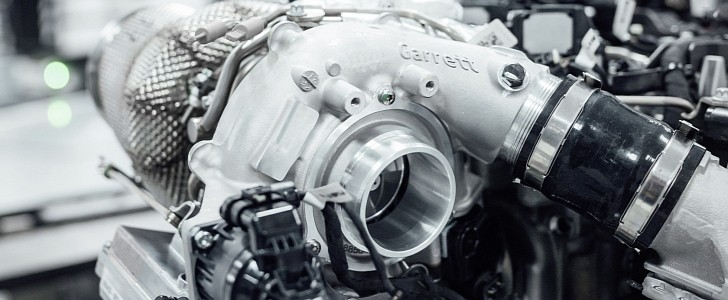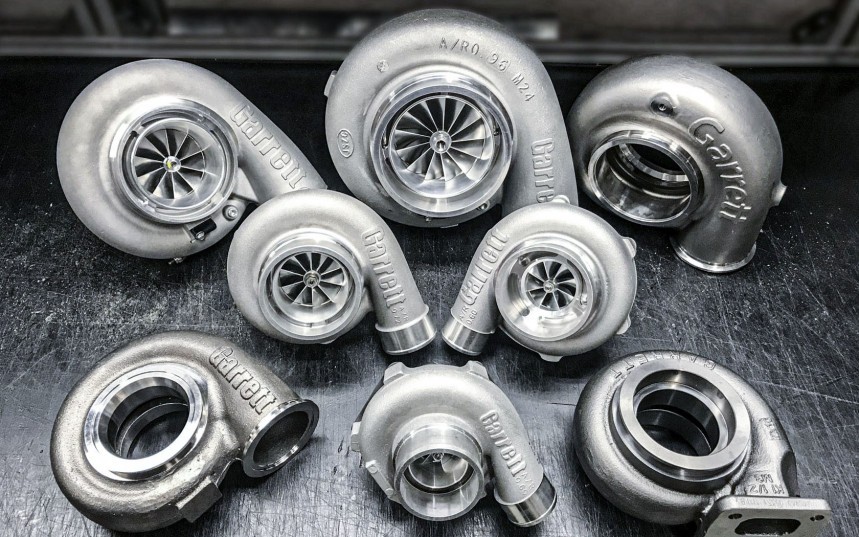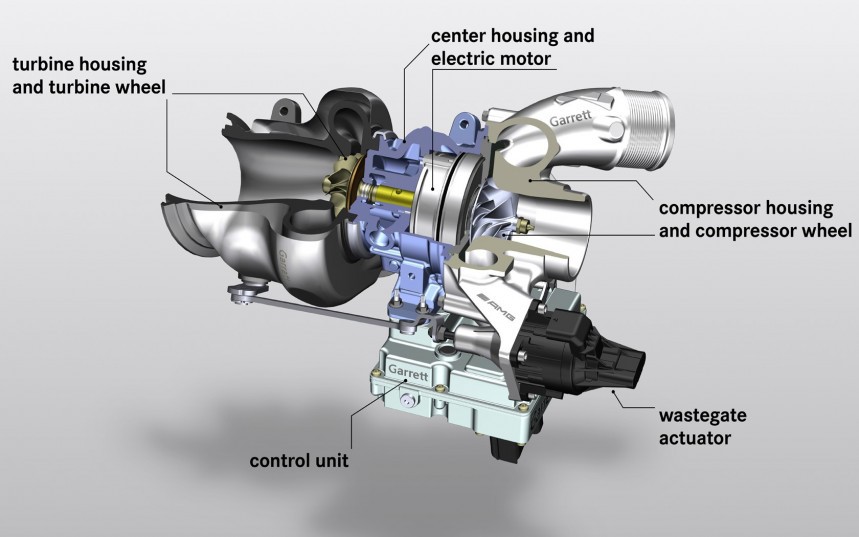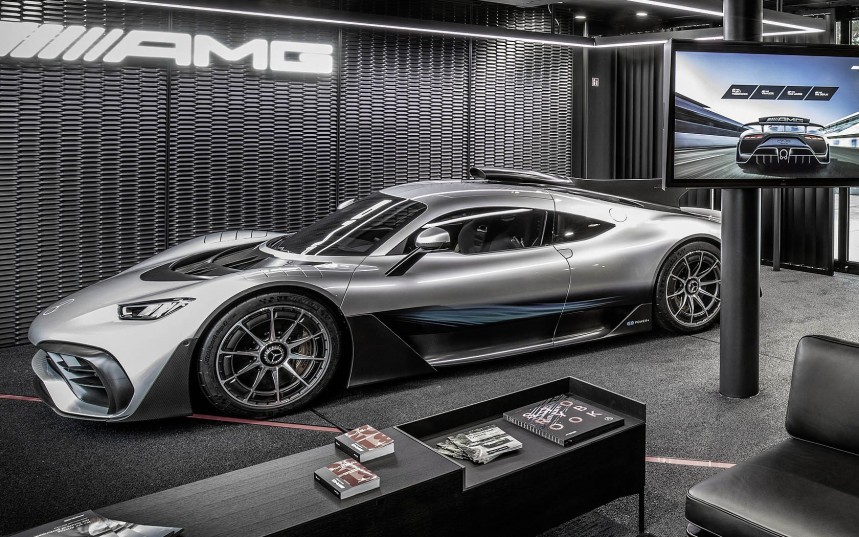The ever-growing need to make smaller, more efficient engines has forced car manufacturers to rethink the traditional turbos and superchargers.
On road cars, the traditional way to get more power out of an engine is to use either a supercharger or a turbocharger. They serve the same purpose, but function differently.
A supercharger is usually driven by the engine crankshaft, while a turbocharger is driven by the engine’s exhaust gasses. Both devices have advantages and disadvantages.
A powerful supercharger creates instant response when slamming the throttle, but it traditionally needs a lot of power from the engine.
An efficiently developed turbocharger needs far less power from the engine but it has a time delay between the moment the gas pedal is pushed, and the moment that the exhaust gasses reach and load up the turbo. This is called turbo lag and the bigger the turbo, the bigger the lag.
Although lag can be reduced by adding a small turbo, it will compromise top-end power. Other compromises that reduce lag are variable-geometry turbos or the use of multiple turbos, but all these add complexity and cost to the engine.
It is an effective and ingenious solution, but logic leads to the conclusion that two devices are bigger, heavier, and more expensive than one. And it still does not supply any regenerative capabilities.
Over the years, Formula 1 has passed down many technological advancements to our road cars, like sequential gearboxes, and it will probably continue to do so. Among the innovative technologies that are set to make the jump to road cars soon is the electronically assisted turbocharger or E-Turbo.
The DOHC 1.6L V6 F1 MGU-H power units used in F1 race cars are the world's most efficient gasoline-fueled racing engines. Their use of electric turbo augmentation adds between 150 and 200 hp to the 850 hp F1 engine.
The E-Turbo is a hybrid turbocharger that works by attaching a small yet immensely powerful electric motor to the turbine section of the turbocharger instead of using an auxiliary device. This ends lag and creates boost the second you push the gas pedal.
The electric motor and its control unit precisely manage boost levels by regulating shaft speed and cutting the need for a traditional wastegate.
When the turbo pallets have reached maximum speed or when the throttle is backed-off it can function as a generator, harnessing the exhaust heat and turn it into electricity that can be sent back to the electric motor, regulate the turbine, or recharge the battery.
The E-Turbo makes sense now because of the vast improvements in brushless electric motor technology and hybrid electrical systems that boost efficiency, found on a growing number of road cars.
These will be able to use small engines that can deliver vast amounts of power, for extended periods without frequent visits to gas or charging stations.
Another benefit of this evolved turbo is the enormous improvement it will bring to performance cars. Mercedes’ AMG division is already on a path of turning electric and as a sign of that they teamed up with Garret Motion, researching and developing what they officially call an electric exhaust gas turbocharger.
They also revealed the epic 2021 AMG Project One, the 1,000 hp hypercar and confirmed they were building and selling 275 of them.
Like Mercedes-AMG, several other manufacturers are developing E-turbos for their cars and as technology advances and costs are cut down
The need to boost the power of an engine with a secondary device has become a requirement in the automotive industry and it is fascinating to see how it will evolve. For conventional, naturally aspirated engines though, it could be the end of the road.
A supercharger is usually driven by the engine crankshaft, while a turbocharger is driven by the engine’s exhaust gasses. Both devices have advantages and disadvantages.
A powerful supercharger creates instant response when slamming the throttle, but it traditionally needs a lot of power from the engine.
An efficiently developed turbocharger needs far less power from the engine but it has a time delay between the moment the gas pedal is pushed, and the moment that the exhaust gasses reach and load up the turbo. This is called turbo lag and the bigger the turbo, the bigger the lag.
It is an effective and ingenious solution, but logic leads to the conclusion that two devices are bigger, heavier, and more expensive than one. And it still does not supply any regenerative capabilities.
Over the years, Formula 1 has passed down many technological advancements to our road cars, like sequential gearboxes, and it will probably continue to do so. Among the innovative technologies that are set to make the jump to road cars soon is the electronically assisted turbocharger or E-Turbo.
The DOHC 1.6L V6 F1 MGU-H power units used in F1 race cars are the world's most efficient gasoline-fueled racing engines. Their use of electric turbo augmentation adds between 150 and 200 hp to the 850 hp F1 engine.
The E-Turbo is a hybrid turbocharger that works by attaching a small yet immensely powerful electric motor to the turbine section of the turbocharger instead of using an auxiliary device. This ends lag and creates boost the second you push the gas pedal.
When the turbo pallets have reached maximum speed or when the throttle is backed-off it can function as a generator, harnessing the exhaust heat and turn it into electricity that can be sent back to the electric motor, regulate the turbine, or recharge the battery.
The E-Turbo makes sense now because of the vast improvements in brushless electric motor technology and hybrid electrical systems that boost efficiency, found on a growing number of road cars.
These will be able to use small engines that can deliver vast amounts of power, for extended periods without frequent visits to gas or charging stations.
Another benefit of this evolved turbo is the enormous improvement it will bring to performance cars. Mercedes’ AMG division is already on a path of turning electric and as a sign of that they teamed up with Garret Motion, researching and developing what they officially call an electric exhaust gas turbocharger.
Like Mercedes-AMG, several other manufacturers are developing E-turbos for their cars and as technology advances and costs are cut down
The need to boost the power of an engine with a secondary device has become a requirement in the automotive industry and it is fascinating to see how it will evolve. For conventional, naturally aspirated engines though, it could be the end of the road.












